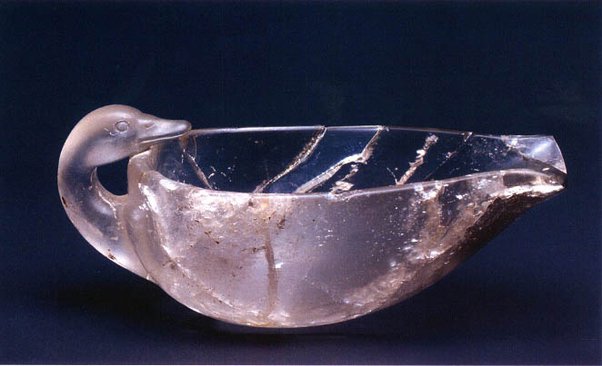A technical definition of glass is an amorphous solid. A curious term that means a substance that cooled from a very high temperature so quickly that it cannot develop regular crystal structures. There are many naturally occurring materials that fit this definition, notably obsidian.
Natural glass is almost always a shade of blue green. Variations in color are the result of impurities within the sand used to make the glass, iron being the primary cause of changes in the shade. Over time glassmakers learned to make different colored glass by mixing in different metals and oxides but it would be many centuries before glassmakers learned to consistently manufacture clear glass.
The reason that sand is such a common ingredient in glass making is that it is rich in silica. Silica is a material that melts at 2000 degrees Celsius, an incredible temperature far beyond the capabilities of most glass making furnaces. By adding sodium carbonate and potassium carbonate to the mixture, the glassmaker can lower the melting temperature.
However, it is a delicate process. Too much of the alkali substances listed above will make glass unstable and even water-soluble. Becoming an early dribble glass if you will. Glassmakers learned to add calcium to the mix to mitigate the effects of the alkalis.
It has been suggested that man probably discovered glass making as an accidental byproduct of metal smelting. If a furnace wall was super-heated and made from the right materials it would melt and if quickly cooled would form puddles of glass in the bottom of the furnace.
The first glass objects created by man on purpose were probably glass beads made in Syria in about 3000 BC. The Egyptians got in on the act a little later and published the earliest known set of instructions for making glass. Although at the time they didn’t make glass vessels, they used it as a protective glaze on pottery.
It would not be until nearly 1500 years later that these same regions began to produce bowls, vases, and glass drinking cups. In these early days of glass making, the alkali mixed with sand was a simple form of sodium carbonate acquired in North Africa.
Ancient Roman glassmakers used a process involving sand, ash, and lime to make all sorts of glassware. The process was expensive and only the wealthiest members of the community could afford glass of any kind. Even tiny fragments of glass were valued as ornaments and in the making of jewelry, occasionally more highly prized than semi-precious stones.
Eventually someone, most likely a potter, discovered that if glass is heated into a nearly liquid state it can be shaped by rolling and will cool into a solid, free standing piece that, unlike it predecessors, was made from a single piece of glass. Before the development of this method, glass vessels were constructed of small pieces joined together. There would be no serious advancement in glass making until the development of glass blowing in the first century AD.
Part two of this incomplete history of glass will cover the development of glass blowing, the related practice of glass molding, and the breakthrough of breakthroughs…clear glass.

